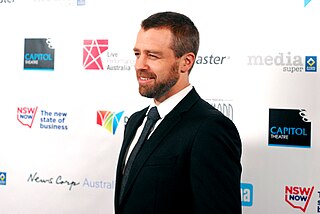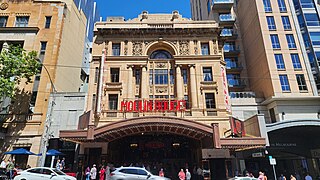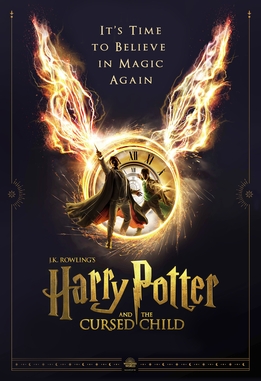
The Palace Theatre is a West End theatre in the City of Westminster in London. Its red-brick facade dominates the west side of Cambridge Circus behind a small plaza near the intersection of Shaftesbury Avenue and Charing Cross Road. The Palace Theatre seats 1,400.

Mamma Mia! is a jukebox musical written by British playwright Catherine Johnson based on songs recorded by Swedish group ABBA and composed by members Benny Andersson and Björn Ulvaeus. The musical's title is taken from the group's 1975 chart-topper "Mamma Mia". Ulvaeus and Andersson were involved in the development of the show from the beginning, while singer Anni-Frid Lyngstad was involved financially in the production and also appeared at many of the premieres around the world.

Anthony Warlow is an Australian musical theatre performer, noted for his character acting and considerable vocal range. He is a classically trained lyric baritone and made his debut with the Australian Opera in 1980.

The Ed Mirvish Theatre is a historic performing arts theatre in Toronto, Ontario, located near Yonge–Dundas Square. Owned and operated by Mirvish Productions, the theatre has approximately 2,300 seats across two levels. There are two entrances to the theatre, located at 263 Yonge Street and 244 Victoria Street.
Efftee Studios was an early Australian film and theatre production studio, established by F.W. Thring in 1930. It existed until Thring's death in 1935. Initially Efftee Films was based in Melbourne and used optical sound equipment imported from the US.

Marina Prior is an Australian soprano and actress with a career mainly in musical theatre. From 1990 to 1993, she starred as the original Christine Daaé in the Australian premiere of The Phantom of the Opera, opposite Anthony Warlow and later Rob Guest.

Simon Gleeson is an Australian actor and singer who is best known for playing Raoul in the 2011 Australian production of Love Never Dies and Jean Valjean in the 2014 Australian revival of Les Misérables. He reprised the role of Valjean in the 2016/17 cast of the West End production. He released an album titled Elements in 2015.

James Cassius Williamson was an American actor and later Australia's foremost impresario, founding the J. C. Williamson's theatrical and production company.

The Regent Theatre is an historic former picture palace built in 1929, closed in 1970, and restored and reopened in 1996 as a live theatre in Collins Street, in the city of Melbourne, Australia. It is one of six city theatres collectively known as Melbourne's East End Theatre District. Designed by Charles Ballantyne in an ornately palatial style, with a Gothic style lobby, Louis XVI style auditorium, and the Spanish Baroque style Plaza Ballroom in the basement, it is listed by the National Trust of Australia and is on the Victorian Heritage Register.

The Hollywood Pantages Theatre, formerly known as RKO Pantages Theatre, is located at Hollywood and Vine in the Hollywood neighborhood of Los Angeles, California, United States. Designed by architect B. Marcus Priteca, it was the last theater built by the vaudeville impresario Alexander Pantages. The palatial Art Deco theater opened on June 4, 1930, as part of the Pantages Theatre Circuit.

Her Majesty's Theatre is a 1,700-seat theatre in Melbourne's East End Theatre District, Australia. Built in 1886, it is located at 219 Exhibition Street, Melbourne. It is classified by the National Trust of Australia and is listed on the Victorian Heritage Register.

Sonia Friedman is a British West End and Broadway theatre producer. On 27 January 2017, Friedman was named Producer of the Year for the third year running at The Stage Awards, becoming the first person to win the award three times. In 2018, Friedman was featured in "TIME100", Time Magazine's 100 Most Influential People of 2018 and was named Broadway Briefing's Show Person of the Year. In 2019, Sonia Friedman Productions was ranked The Stage 's most influential theatre producer in The Stage 100.

Francis William Thring III, better known as F. W. Thring, was an Australian film director, producer, and exhibitor. He has been credited with the invention of the clapperboard.

Frederick Federici was an Italian-born British opera singer known for his work in the bass-baritone roles of the Savoy Operas written by Gilbert and Sullivan. He is also remembered as a reputed theatre ghost in Australia.

The TBS Akasaka ACT Theater is a theatre located in Akasaka, Minato, Tokyo, Japan. Completed in 2008, the four-storey 28.9 metres (95 ft) high theatre has a capacity of 1,324 seats. In September 2014 the theatre is showing Arthur Kopit's musical version of the Gaston Leroux classic, The Phantom of the Opera. The theater is dedicated to the stage production of Harry Potter and the Cursed Child from June 2022.

Harry Potter and the Cursed Child is a play written by Jack Thorne from an original story written by J. K. Rowling, Thorne and John Tiffany. The story is set nineteen years after the events of the 2007 novel Harry Potter and the Deathly Hallows by Rowling. It follows Albus Severus Potter, son of Harry Potter, who is now Head of the Department of Magical Law Enforcement at the Ministry of Magic. When Albus arrives at Hogwarts, he gets sorted into Slytherin, and fails to live up to his father's legacy, making him resentful of his father. Rowling has referred to the play as "the eighth Harry Potter story".
Playground Entertainment is a television, film and theatre production company with offices in New York and London, founded in 2012 by Sir Colin Callender, former President of HBO Films.
Garnet Hannell Carroll, was an Australian actor, theatre owner and theatrical director and producer. He helped coloratura soprano Gertrude Johnson establish the Melbourne National Theatre.
Henry Osborne Jacobs was an English musician best known as an accompanist, arranger and conductor for Ada Reeve, then settled in Australia, where he had a substantial career.
The Arrow Theatre was an Australian theatre in the Melbourne suburb of Middle Park. It was located at 1–3 Armstrong Street, opposite the Middle Park railway station. It seated only 200 persons but had a stage large enough for ambitious productions.






















